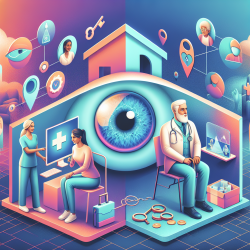The eSALT Platform: A Brief Overview
eSALT is an asynchronous telerehabilitation platform designed to offer flexible and personalized therapy tasks for individuals with aphasia. Clinicians can create and customize tasks, which are then transferred to a client's mobile device for home-based therapy. The platform allows for remote monitoring and updating of tasks, thus eliminating scheduling conflicts and improving therapy access.
Key Findings from the Usability Study
The study involved five participants with aphasia and three speech-language pathologists (SLPs), focusing on the usability and acceptability of eSALT. Here are the main takeaways:
- Usability: Both clinicians and clients found the platform generally easy to use, although some improvements were suggested, such as better touchscreen responsiveness and more intuitive navigation.
- Support and Training: Adequate training and ongoing support were crucial for successful use. Initial in-person training and follow-up home visits were highly valued.
- Remote Monitoring: While some participants appreciated the remote monitoring of their progress, others felt neutral about it. Providing feedback on progress through the platform could enhance motivation.
- Task Customization: Clinicians appreciated the ability to personalize tasks but found the process time-consuming. More task templates and easier customization options were recommended.
- Satisfaction: High levels of satisfaction were reported, particularly due to the flexibility and increased therapy intensity achievable through eSALT.
Practical Recommendations for Practitioners
Based on the study's findings, here are several recommendations for practitioners looking to implement or improve their use of asynchronous telerehabilitation platforms:
- Invest in Training: Ensure both clinicians and clients receive comprehensive training. Consider follow-up sessions to address any ongoing issues.
- Enhance Feedback Mechanisms: Incorporate features that provide clients with real-time feedback on their progress to boost motivation and engagement.
- Streamline Task Customization: Utilize pre-made templates and task libraries to reduce the time spent on task creation. Regularly update these resources based on user feedback.
- Support Systems: Develop robust support systems, including easy access to technical assistance and clear, user-friendly manuals.
- Leverage Data: Use the data collected through the platform to make informed decisions about therapy adjustments and to track client progress effectively.
Future Directions
The study highlights the importance of continuous refinement based on user feedback. Future developments could include expanding the platform to other operating systems, enhancing data visualization tools for clinicians, and further simplifying the user interface.
Conclusion
Asynchronous telerehabilitation platforms like eSALT hold significant promise for enhancing speech-language pathology services. By incorporating the insights from this usability study, practitioners can optimize their use of such platforms, leading to better outcomes for their clients.
To read the original research paper, please follow this link: Refining an Asynchronous Telerehabilitation Platform for Speech-Language Pathology: Engaging End-Users in the Process










